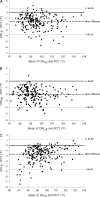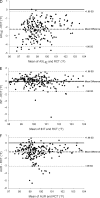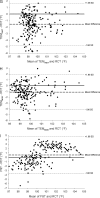Validity and reliability of devices that assess body temperature during indoor exercise in the heat
- PMID: 19295956
- PMCID: PMC2657027
- DOI: 10.4085/1062-6050-44.2.124
Validity and reliability of devices that assess body temperature during indoor exercise in the heat
Abstract
Context: When assessing exercise hyperthermia outdoors, the validity of certain commonly used body temperature measuring devices has been questioned. A controlled laboratory environment is generally less influenced by environmental factors (eg, ambient temperature, solar radiation, wind) than an outdoor setting. The validity of these temperature measuring devices in a controlled environment may be more acceptable.
Objective: To assess the validity and reliability of commonly used temperature devices compared with rectal temperature in individuals exercising in a controlled, high environmental temperature indoor setting and then resting in a cool environment.
Design: Time series study.
Setting: Laboratory environmental chamber (temperature = 36.4 +/- 1.2 degrees C [97.5 +/- 2.16 degrees F], relative humidity = 52%) and cool laboratory (temperature = approximately 23.3 degrees C [74.0 degrees F], relative humidity = 40%).
Patients or other participants: Fifteen males and 10 females.
Intervention(s): Rectal, gastrointestinal, forehead, oral, aural, temporal, and axillary temperatures were measured with commonly used temperature devices. Temperature was measured before and 20 minutes after entering the environmental chamber, every 30 minutes during a 90-minute treadmill walk in the heat, and every 20 minutes during a 60-minute rest in mild conditions. Device validity and reliability were assessed with various statistical measures to compare the measurements using each device with rectal temperature. A device was considered invalid if the mean bias (average difference between rectal and device temperatures) was more than +/-0.27 degrees C (+/-0.50 degrees F).
Main outcome measure(s): Measured temperature from each device (mean and across time).
Results: The following devices provided invalid estimates of rectal temperature: forehead sticker (0.29 degrees C [0.52 degrees F]), oral temperature using an inexpensive device (-1.13 degrees C [-2.03 degrees F]), temporal temperature measured according to the instruction manual (-0.87 degrees C [-1.56 degrees F]), temporal temperature using a modified technique (-0.63 degrees C [-1.13 degrees F]), oral temperature using an expensive device (-0.86 degrees C, [-1.55 degrees F]), aural temperature (-0.67 degrees C, [-1.20 degrees F]), axillary temperature using an inexpensive device (-1.25 degrees C, [-2.24 degrees F]), and axillary temperature using an expensive device (-0.94 degrees F [-1.70 degrees F]). Measurement of intestinal temperature (mean bias of -0.02 degrees C [-0.03 degrees F]) was the only device considered valid. Devices measured in succession (intestinal, forehead, temporal, and aural) showed acceptable reliability (all had a mean bias = 0.09 degrees C [0.16 degrees F] and r >or= 0.94]).
Conclusions: Even during laboratory exercise in a controlled environment, devices used to measure forehead, temporal, oral, aural, and axillary body sites did not provide valid estimates of rectal temperature. Only intestinal temperature measurement met the criterion. Therefore, we recommend that rectal or intestinal temperature be used to assess hyperthermia in individuals exercising indoors in the heat.
Keywords: core body temperature; hyperthermia; tympanic membrane.
Figures




Similar articles
-
Validity of devices that assess body temperature during outdoor exercise in the heat.J Athl Train. 2007 Jul-Sep;42(3):333-42. J Athl Train. 2007. PMID: 18059987 Free PMC article.
-
Validity of field expedient devices to assess core temperature during exercise in the cold.Aviat Space Environ Med. 2011 Dec;82(12):1098-103. doi: 10.3357/asem.3102.2011. Aviat Space Environ Med. 2011. PMID: 22195389
-
Validity of Core Temperature Measurements at 3 Rectal Depths During Rest, Exercise, Cold-Water Immersion, and Recovery.J Athl Train. 2017 Apr;52(4):332-338. doi: 10.4085/1062-6050-52.2.10. Epub 2017 Feb 16. J Athl Train. 2017. PMID: 28207294 Free PMC article.
-
Non-Contact Thermometers for Detecting Fever: A Review of Clinical Effectiveness [Internet].Ottawa (ON): Canadian Agency for Drugs and Technologies in Health; 2014 Nov 20. Ottawa (ON): Canadian Agency for Drugs and Technologies in Health; 2014 Nov 20. PMID: 25520984 Free Books & Documents. Review.
-
Thermometry in paediatric practice.Arch Dis Child. 2006 Apr;91(4):351-6. doi: 10.1136/adc.2005.088831. Arch Dis Child. 2006. PMID: 16551792 Free PMC article. Review.
Cited by
-
Evaluation of a Wearable Non-Invasive Thermometer for Monitoring Ear Canal Temperature during Physically Demanding (Outdoor) Work.Int J Environ Res Public Health. 2021 May 4;18(9):4896. doi: 10.3390/ijerph18094896. Int J Environ Res Public Health. 2021. PMID: 34064464 Free PMC article.
-
Perceptions of Secondary School Athletic Trainers in the Diagnosis of Exertional Heat Stroke.J Athl Train. 2020 Oct 1;55(10):1070-1080. doi: 10.4085/1062-6050-0247.19. J Athl Train. 2020. PMID: 32947610 Free PMC article.
-
Cold-Water Immersion Cooling Rates in Football Linemen and Cross-Country Runners With Exercise-Induced Hyperthermia.J Athl Train. 2017 Oct;52(10):902-909. doi: 10.4085/1062-6050-52.7.08. Epub 2017 Sep 22. J Athl Train. 2017. PMID: 28937782 Free PMC article.
-
Test and Evaluation of Heart Rate Derived Core Temperature Algorithms for Use in NCAA Division I Football Athletes.J Funct Morphol Kinesiol. 2020 Jul 6;5(3):46. doi: 10.3390/jfmk5030046. J Funct Morphol Kinesiol. 2020. PMID: 33467262 Free PMC article.
-
Roundtable on Preseason Heat Safety in Secondary School Athletics: Prehospital Care of Patients With Exertional Heat Stroke.J Athl Train. 2021 Apr 21;56(4):372-382. doi: 10.4085/1062-6050-0173.20. J Athl Train. 2021. PMID: 33290540 Free PMC article.
References
-
- Dombek P.M, Casa D, Yeargin S.W, et al. Athletic trainers' knowledge and behavior regarding the prevention, recognition and treatment of exertional heat stroke at the high school level [abstract] J Athl Train. 2006;41(2 suppl):S–47.
-
- Kongpanichkul A, Bunjongpak S. A comparative study on accuracy of liquid crystal forehead, digital electronic axillary, infrared tympanic with glass-mercury rectal thermometer in infants and young children. J Med Assoc Thai. 2000;83(9):1068–1076. - PubMed
-
- Greenes D.S, Fleisher G.R. When body temperature changes, does rectal temperature lag. J Pediatr. 2004;144(6):824–826. - PubMed
Publication types
MeSH terms
LinkOut - more resources
Full Text Sources
Other Literature Sources
Medical
Miscellaneous

